Don't Let It Happen Here
(A review reprinted from issue #199 of The Wrapper non-sports collecting magazine).
By Joel P. Bevan
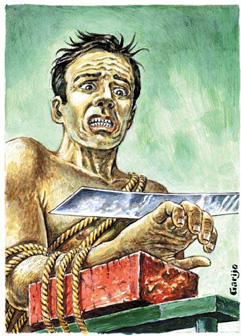
It is a picture of a man. Or rather, a drawing of a man is what we see, bound, shirtless, terrified. This man has a stout rope twisted about his waist and shoulder and this same rope lashes his forearm tightly to a reddish block of wood. Poised just above his wrist, an unseen hand brandishes a huge gleaming knife, almost a sword. His face is wild and contorted, black hair all akimbo, eyes bulging out and his teeth exposed in a grimace of horror. He can't take his eyes off of the KNIFE. "Amputation" is the title of this non-sport trading card.
Now we get it. Amputation! Not a cold, surgical procedure done by doctors clad in white, but a grisly swipe of a blade intended to mete out some primitive form of justice or revenge. Amputation !
This card is one of a brand new set entitled Don't Let it Happen Here, produced by Monsterwax. The author and creator of the set is Kurt Kuersteiner of Monsterwax fame. Wrapper subscribers will recognize Kurt as the regular contributing feature writer for The Wrapper magazine.
This issue we reversed roles a bit and I interviewed Kurt about his new card set and asked him why he is so excited about it. I found myself getting very interested in the 2003 version of Don't let It Happen Here, myself.
Written on the front side of Amputation, as on every card of this set, is the signature Garijo. That is short for Ricardo Garijo, the Argentinean artist who has done such a magnificent job with colors and artwork that go into each card and make Happen Here the masterpiece that it is.
We discussed how the new set captures both the physical likeness of the older set as well as the unapologetic spirit of the original. "Do your bit: Get all the cards and show them to everyone." So says the small print on the backs of both sets, the old and the new alike.
Here then is the faithful transcription of that interview and I ask my readers to imagine Kurt's animation and enthusiasm, which the printed word cannot recapture.
-The Interview-
Kurt, so what is the scoop? When exactly can Wrapper readers view your new set on the net and when does the complete set go on sale?
Very soon, November/ December 2003. They can check out the site now at: https://www.Monsterwax.com/HappenHere.html
Tell us about Don't Let It Happen Here. What does the set look like and how many cards make up a complete set?
There are fifty cards in the set, with the #50 card being the checklist. The fronts feature vibrant color images of shocking world events. The backs give straightforward accounts of the incidents, pulling no punches.
Limited edition?
Very much so. Only four hundred and fifty boxes, with no reprints or reissues ever to be produced. So that works out to less than 2000 sets available if every box is broken and sorted.
So, folklore has it that this new version of an old classic was a product of sudden inspiration. Is it true that the concept for Happen Here came to you while you were reading a newspaper account about current events?
As a matter of fact, that is exactly what happened. I can tell you right now what the story was. It was an article about Chechnya. After one pitched battle with Chechnya separatists, a truce was called and the rebels paid the Russians to allow them to leave the battlefield.
Instead, the Russians lured them into a mine field and opened up on them with artillery. The only way any of them could escape was for them to run ahead and sacrifice themselves. They detonated the mines and their companions ran from behind onto the dead bodies, like stepping stones of corpses, to freedom.
I was both shocked by the story and moved by how much we take our freedom for granted.
Well, let me build on that last question. After you received this inspiration for the conception of a trading card set, did the full vision come all in a bright flash or did you labor on it ?
Well at first I thought that I was just going to do something like the first set. I figured it was the writing, the stories that carried the original Happen Here set, because the artwork was crude. Then I thought to myself, "I can do better than that, I can find twenty four new stories and a great artist to do the pictures." Soon thereafter I read another account of how Afghanistan publicly executed killers. They would take them into stadiums full of cheering crowds and let the relatives of the victims slit their throats. The actual events were so dramatic that I began to research the papers more and realized that I must double the twenty four card set to fifty cards.
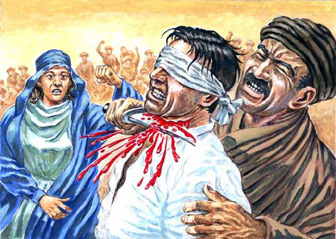
Once you had the overall notion firmed up, how long did the actual production last ?
About three years. I started writing the texts in 2000 and only finished up a few months ago. But it took two years to find the right artist and his artwork took about nine months. I was stunned with how fast a worker Ricardo was.
I imagine that locating the right artist was the most difficult decision ?
As I compiled the stories, I became convinced that this was not going to be just any set, but a major set, maybe the biggest one I would ever do. I looked and looked at a number of artists and their work. I decided to wait until I got not just a good artist, but a phenomenal artist. Then the right guy happened to fall in my lap.
Through the internet I bought a Spanish version of Mars Attacks from him. His name was Ricardo Garijo of Argentina. In our exchange of emails, he mentioned that he was an artist. Although I did not think for a minute that he was the person I was looking for, I replied, 'sure send me some samples of your work'. When I saw his work, however, that all changed and I knew that this was the artist I had been searching for.
By the way, we even worked in a Mars Attacks card into the new Happen Here set. It is Destroying a Dog #36 (same # as the original.) Only in our version, we illustrate how in Germany the state has sanctioned genocide against certain breeds of dogs. They can and do break into houses without warrants to kill dogs that happen to be the wrong breed.

On a technical note, your set is visually superior to the 1938 Happen Here original. Why is yours ending up more attractive?
Our artist had real talent and theirs didn't. (Laughs.) The original series is still a collector's favorite because of the graphic images, bold text and patriotism. Now we have all that and really fantastic artwork.
You should have seen the people gather around me at Kinko's when I tried to Xerox some of the images. They couldn't believe their eyes or ears when I related some of the true stories.
Well, you made the right choices. I have carefully looked over the sample cards you have on the net. I saved them to an application on my pc and then blew them up to the full 19" on my monitor. They do not lose resolution and at that size you can really appreciate the detail of the artwork and coloring. They are actually beautiful.
It is interesting that you say they are beautiful because I rather have that same feeling. Yet I have to remind myself that these are not beautiful topics. It is like looking at some of the great artwork in museums. Often the theme is not pleasant but we appreciate the beauty of the workmanship. Ricardo has a wonderful presentation skill.
Long time Wrapper readers and serious collectors of picture cards are going to be familiar with the 1938 edition of Don't Let It happen Over Here, which I might add, has one more word in its title than yours. On your web site you state that your cards would "pay homage" to the older set. Was this 1938 set just a starting point, a model to copy or perhaps to bring around into a modern context or what was your notion of the relationship?
Well, I love movies but I would not remake one unless I thought I could shoot one better than the original. I would never attempt to redo Horrors of War or Mars Attacks because they cannot be improved upon. But let's face it, the 1938 series of Happen Here had one glaring shortcoming: The artwork was nothing to get excited about. So that aspect is the only change we set out to make. We kept faithful to the original concepts; current world events that demonstrate how lucky we are to be Americans. We even kept the same back side formats and fonts.
But I went out of my way to get an exceptional artist in order to upscale the one thing I think the original manufacturer would have done if they could. And that was to match the great writing with great art.
One of the wonderful things about non-sport trading cards is that they can be a snapshot of an age. Preserving details, with pictures and text, they each portray a short story or vignette about some chapter in a larger tale or reveal some character of a great era.
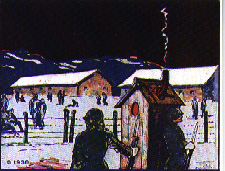
Let's look at the older set and choose, say #17. Its title was Horror Camps of Naziland. The picture shows a bleak dark sky. There are rough wood buildings on a snowy patch of ground, with prisoners on one side of barbed wire and guards on the other. The text describes the horror of Nazi concentration camps. Now mind you, this was 1938, long before the Jewish holocaust or the full scale fighting of WW2 in Europe. So we ask ourselves, is this set merely entertainment or is there a presentiment message contained herein?
There is definitely a message and it is the same one as it was when printed on the 1938 wrapper: "These cards show murder, death and destruction taking place in the world today. Be glad you live in the good old U.S.A."
All right, let's shift back to the 2003 Happen Here cards. For example card #7 Acid Attack in Bangladesh ---- men throwing acid into the faces of women in that far off land. Is this account factual or fictional?
The attacks on women still exist. It is shocking to know that the men not only scar the young women who refuse to love them, but the police rarely punish those who commit the terrible crime. Less than 10% go to trial because the police take so many bribes. The deed is actually common and occurs scores of times each year.
If I asked you if you had a favorite card in your own set, would you be able to choose you one?
Yes, probably the first card, #1 Free Speech in Iraq. In the year 2000, in Iraq, a law was passed and then broadcast on television that if you criticized Saddam Hussein they would amputate your tongue.
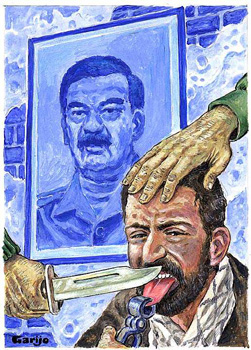
When I stare at the drawing on this card, which I am doing now, I see a close up face of an unfortunate man. Someone has a rough hand around the top of his head, his tongue is protruding and held in type of a clasp and another unseen man is holding a razor sharp knife under his tongue. When I see this picture, I put away what I think I know about that portion of the world and just say to myself, Stop! Don't do that, don't cut.
It is a haunting image.
(Earlier it was my supper time and I was ready to call Kurt on the phone. As the wife brought me a plate of food, I brought up the Happen Here pictures on my pc to look at full sized. Unfortunately the first one on the slideshow was Cannibalism. It is a jungle setting, with four or five green fatigue clad soldiers around a fire. Only this fire is a roasting spit and the ribs of a human victim are barbecuing to a turn while the soldiers much on a limb or a bone and someone is cutting a nice slice. The head and one foot of the guest of honor at the feast rests on the ground in a little blood puddle, tongue lolling out. Suddenly I am not hungry for supper anymore.)
I asked Kurt about this card:
So this beheaded victim in the jungle whose ribs are turning over the fire pit sure looks a lot like Harry Truman to me. How come you didn't use Tom Dewey for a model here ?
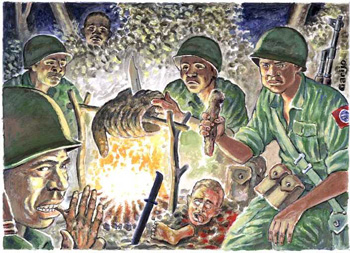
(laughs) I don't think Ricardo had that caricature in mind when he drew the picture.
Have you invited controversy by using lurid pictures?
These are pictures of stories that if the media could have gotten photos of they probably would have printed them. Reporters would hardly be allowed near any of these events and likely wouldn't be left alive if they were on the spot to film them. So what we did was create the pictures of incidents that we knew had occurred and tried to do them as realistically as possible.
This is my last question. Can your set, Don't Let It happen Here, appeal to the younger generation of card collectors? Let me re-state that query first. Most Wrapper readers are in their 40's or 50's. Before long they will be 60, 70 and then they will be dead. Can Happen Here draw in the children who now collect Yu-Gi-Oh and place them where we are now to appreciate and collect real gum cards?
I hope they do. But in truth that is not why I made them. I only make sets that I would want to collect myself. Fortunately I tend to like the same sorts of things as collectors do. Let's hope that taste preference crosses the age difference as well.
So there we have it for the record. More than that I cannot add except to re-quote the tiny print found on the reverse side of each card of the 1938 and 2003 Don't Let It Happen Here sets: Do your bit. Get all the cards and show them to everyone.

Above: Japanese Subway Gas Attack
Ricardo Garijo is the artist who has painted each of the forty-nine images in the 2003 Don't Let It Happen Here set. His choice of colors enhances the visual appeal of each picture card and imprints a unique touch which contributes to the finished, complete set.
Ricardo was born in Argentina in 1953. The second son of Spanish immigrant parents, he states that his father survived a German concentration camp in WW2 (Mauthausen, Austria), while his mother was active in the French Resistance. On an obscure note, Ricardo said that when he was baby, his mother swaddled him in clothing made from a British parachute.
By watching American movies and listening to the Beatles, Ricardo managed to learn English. He developed two passions as a boy, the American space program and the Second World War. For thirty years he collected photographs, books and magazine articles about the early space flights. Ricardo composed numerous drawings of the astronauts. In 1986 he was invited by NASA to exhibit some of his work in Argentina. He received a personal letter from another artist, the astronaut Alan Bean, who was the fourth human to walk on the moon.
In 1977, when he was 23 years old, Ricardo decided to expand his horizons and journeyed to Europe, hitchhiking from Spain to Sweden.
Mr. Garijo has worked on graphic media since 1980. As a science fiction fan, he transitioned easily into graphic artwork for two newspaper comic strips. By 1982 he went to work for the Thomson House of Dundee, Scotland. Since then he has drawn thousands of pages of war cartoons and illustrations.
In the 1990s he began creating comics for other European periodicals. They were published in Spain, France and Italy. Six years ago senor Garijo began the publication of his own magazine named Gurbos in Extinction which was conceived as a tribute to the old Argentinean comic creators, some of the best in the world. His last published work from Gurbos, The Diary of Moreno Square, is a fantasy story about his own home town.
In his own words, Ricardo says, "Kurt has given me a chance to show my work to the Americans with the trading card set Don't Let It Happen Here. I only know Kurt by email but it is amazing what two guys can accomplish without ever meeting each other."
Ricardo has been married to Adriana since 1980. She is a teacher. Together, they have had three children, a boy and two girls.
-End-